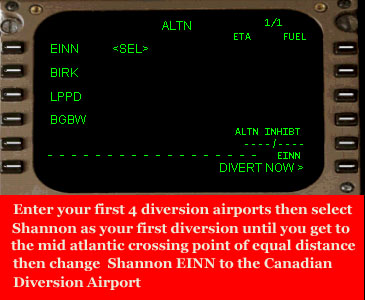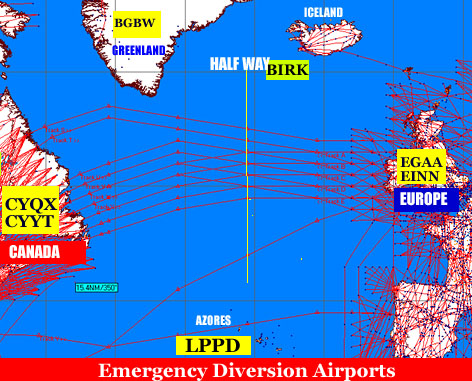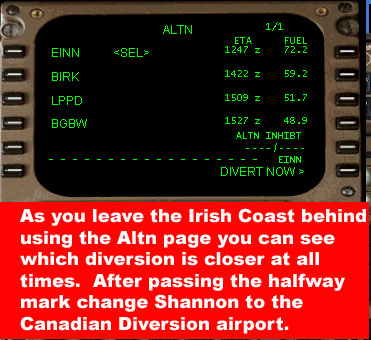

Flying the Atlantic using the FMC for Diversion Airports & ETOPS
Because the 767 is a twin engined jet ETOPS procedures apply. Basically the aircraft must always be within 3 hours flying time of an airport that has weather limits at or above the minimums when the aircraft is due in area. This equals about a 1300 NM ETOPS radius as a rule of thumb.
The North Atlantic airways are the most heavily utilized oceanic routes in the world. Most routes are conveniently covered by ETOPS-120min rules, removing the necessity of utilizing 180-min rules. However, many of the North Atlantic diversion airports, especially those in Iceland and Greenland, are frequently subject to adverse weather conditions making them unavailable for use. As the 180-min rules is the upper limit, the JAA has given 15% extension to the 120-min rules to deal with such contingencies, giving the ETOPS-138min thereby allowing ETOPS flights with such airports closed.
Due to jet stream winds the Atlantic track routes structure changes every day. The navigation program Flight Sim Commander can plot these tracks for you, so its well worth purchasing this program. The tracks have letters for identification. Tracks A to E are westbound between 1130 UTC to 1900 and tracks S to Z are Eastbound valid from 0100 to 0800 UTC height restrictions apply also normally in the range between FL290 and FL400 are only allowed. Some tracks are specific times only.
You can check these tracks each day at this URL https://www.notams.jcs.mil/common/nat.html
Once you have plotted the tracks, you can then use the FMC alternate page and program the alternate airports into the FMC


I suggest Diversion airports are Shannon or Belfast on the Europe side of the Atlantic.
For Northern tracks Reykjavik BIRK, Narsarsauq BGBW would be intermediate diversion airports.
Gander CYQX or St Johns CYYT on the Canadian Side of the Atlantic or for those on more southerly tracks the Azores airports of Ponte Delgarda LPPD may be an option instead of Reykjavik. for a second point depending on the track you use on the day.
What you need to do is plot the half way points between The Irish mainland diversion airport and the Canadian coast Diversion Airport first.
Rule of thumb 30 W is a guide.

This map shows the diversion airports and the track for the east and westbound flights for the day that I made this lecture. This map is made by FS Commander.
On the track I have today it is 51N30W is about halfway. This was on Track E .
On route as you leave the coast of Europe you can then constantly check either Iceland or Azores to see which is going to be the closest as a second alternate.

The time I took this screenshot below was 12 36UTC on the flight as shown below.I used Track Echo for a recent flight from Stansted to Bermuda passing off Lands End South of Ireland to Somax waypoint The last picture shows Shannon the nearest for Diversion. As the aircraft progresses then the ETA constantly changes time to each airport.
As you go westbound and past 51N 30W this is the halfway point of the Atlantic crossing on this track today. Delete EINN from the page and put in the Canadian Diversion airport on the Altn page. The half way point is about 850NM from EINN CYYT and LPPD all of about equal distance well within ETOPS range.
Now all you have to do is watch which airport is closest to fly to in an emergency the ALTN page gives ETA at the diversion airports then select the nearest one and divert in an emergency if necessary..
Now you have complied with ETOPS and your safety awareness has improved.
In an emergency you have to consider flying the aircraft at all times first. Then advise ATC advise other pilots in the area on the pilot chit chat frequency or distress frequency. Turn 90 degrees of the track system for any emergency descent . If returning behind you say to Shannon offset your route so that you do not pass other traffic head on on the track system until you get in radar range for normal ATC to seperate you by radar. USE TCAS.
Be safe and one step ahead of the game at all times with regards to Diverting.
Please Refresh your memory on the ETOPS and Atlantic procedures. It is more complicated than as explained ,but I hope this gives you a basic idea so you can enjoy your flight simulation that bit more. Now applying the principles used.
Further Information on the Virtual Airline Operations Page
There are also some excellent short free videos on this link which explain the Atlantic Diversion Rules and there are some Oceanic Check Lists you can download on this site
Click on the DVD and look for the links on the right track there are menus with all sorts of information on with regard to diversions etc
You can also use the ALTN page for internal flights for on route emergencies in a similar manner.